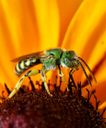Texas Striped Sweat Bee
Agapostemon texanus
Classification
- Phylum: Arthropoda
- Subphylum: Hexapoda
- Class: Insecta
- Order: Hymenoptera
- Family: Halictidae
- Subfamily: Halictinae
- Tribe: Halictini
- Genus: Agapostemon
- Species: texanus
Pronunciation
How to pronounce Agapostemon texanus: /ˌæɡəˈpɒstɪmɒn tɛkˈseɪnəs/
These audio files are automatically generated. While they are not always 100% accurate, they are a good starting point.
Images






Summary
Agapostemon texanus, also known as the Texas striped sweat bee, is a ground-nesting bee found primarily in North America. They exhibit various colors, primarily metallic blue and green, and have a solitary nesting habit. They play a significant role in pollination and have a wide distribution range.
Physical Characteristics
Females about 11 mm in length, males between 9-10 mm. The head and thorax are bright metallic blue or green. Males distinguished by black and yellow bands on the metasoma, while females are typically one color. Scutum of female shining with 'double punctate' punctures of two different sizes.
Identification Tips
Look for green reflections on terga, dark scape, and large femur in males. Females have a more uniform color. Both sexes have characteristic sizes.
Habitat
Ground nesting species found in loamy soil; prefers open areas with access to flowers and hidden spots for nesting.
Distribution
Range covers southern Canada to Costa Rica, most common west of the Mississippi River and the west coast of the United States. Found at various elevations from sea level to 8,000 feet in California’s Sierra Nevada.
Diet
Generalist forager; visits flowers from several families; not observed to favor specific flowers.
Life Cycle
Flight season spans March to October, with peak activity from May to September. Adults transport pollen on hind legs.
Reproduction
Females are solitary nesters; lay eggs in individual cells. Each cell is sealed after egg deposition with a secretion from the female.
Predators
Predators include crab spiders (Thomisidae), ambush bugs (Phymatidae), Philanthe wasps (Sphecidae), robber flies (Asilidae). Blister beetle (Meloidae) larvae can also be found on adults or in cells.
Ecosystem Role
Pollinates a variety of flowers as a forager; contributes to plant reproduction and ecosystem health.
Collecting Methods
- Net capture during foraging activities
- Ground trapping near nesting sites
Preservation Methods
- Preserved in alcohol
- Pinned specimens
Similar Taxa
Misconceptions
Though called 'sweat bee', they are not aggressive and typically only sting when provoked. Their affinity for sweat is due to salt, not aggression.
Tags
- bee
- sweat bee
- pollinator
- solitary nester